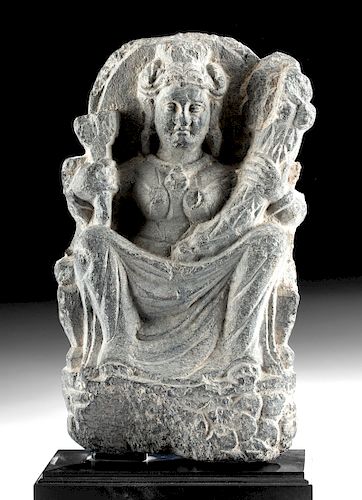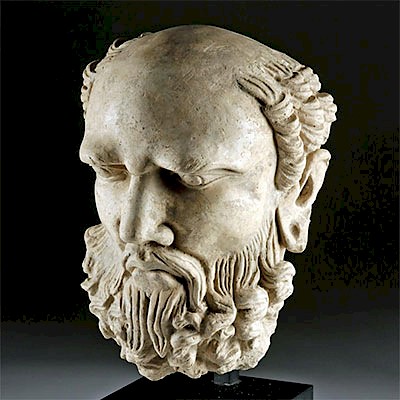Rare Gandharan Stone Statue of Hariti
Lot 161a
About Seller
Artemis Fine Arts
686 S Taylor Ave, Ste 106
Louisville, CO 80027
United States
Selling antiquities, ancient and ethnographic art online since 1993, Artemis Gallery specializes in Classical Antiquities (Egyptian, Greek, Roman, Near Eastern), Asian, Pre-Columbian, African / Tribal / Oceanographic art. Our extensive inventory includes pottery, stone, metal, wood, glass and textil...Read more
Categories
Estimate:
$1,500 - $2,000
Absentee vs Live bid
Two ways to bid:
- Leave a max absentee bid and the platform will bid on your behalf up to your maximum bid during the live auction.
- Bid live during the auction and your bids will be submitted real-time to the auctioneer.
Bid Increments
| Price | Bid Increment |
|---|---|
| $0 | $25 |
| $300 | $50 |
| $1,000 | $100 |
| $2,000 | $250 |
| $5,000 | $500 |
| $10,000 | $1,000 |
| $20,000 | $2,500 |
| $50,000 | $5,000 |
| $100,000 | $10,000 |
| $200,000 | $20,000 |
About Auction
By Artemis Fine Arts
Jan 16, 2020
Set Reminder
2020-01-16 10:00:00
2020-01-16 10:00:00
America/New_York
Bidsquare
Bidsquare : Ancient | Asian | Ethnographic
https://www.bidsquare.com/auctions/artemis-gallery/ancient-asian-ethnographic-4799
Featuring classical antiquities, ancient and ethnographic art from cultures encompassing the globe. Artemis Fine Arts info@artemisgallery.com
Featuring classical antiquities, ancient and ethnographic art from cultures encompassing the globe. Artemis Fine Arts info@artemisgallery.com
- Lot Description
Central Asia, Pakistan and Afghanistan, Gandharan Empire, ca. 2nd to 3rd century CE. A finely carved, grey schist relief panel representing the goddess Hariti from the Gandharan Empire. While often depicted as a woman surrounded by or nursing several children, here she holds a cornucopia in her left hand and a pomegranate in her right hand. Stylistically, the attention to the drapery, the sinuous, wavy Mediterranean hair, as well as the sensitive modeling of Hariti's expressive face demonstrate a great classical influence. Alexander the Great conquered Gandhara in 330 BCE and with the help of the Indo-Greek kings introduced classical traditions that would influence Gandharan art for the following seven centuries. Size: 3.75" W x 6.5" H (9.5 cm x 16.5 cm); 7.85" H (19.9 cm) on included custom stand.
According to Buddhist mythology, Hariti had hundreds of children whom she adored. However, in order to feed them, she kidnapped and slaughtered other children. The grieving mothers asked Buddha to put an end to Hariti's actions. He abducted her youngest son and hid him under his rice bowl. After a desperate search, Hariti appealed to Buddha, who explained that her suffering was due to the loss of only one of her hundreds of children. He asked her to imagine the immense suffering of the parents who lost their only children. Upon hearing this, Hariti vowed to be a devout protector of children as well as women in childbirth. In return the Buddha gifted her with bodhi which empowered her to counter evil and cure the sick. From that moment on, she ate pomegranates instead of human flesh.
Provenance: private J.H. collection, Beaverton, Oregon, USA, acquired in October 2009; ex-Tom Cederlind collection, Portland, Oregon, USA
All items legal to buy/sell under U.S. Statute covering cultural patrimony Code 2600, CHAPTER 14, and are guaranteed to be as described or your money back.
A Certificate of Authenticity will accompany all winning bids.
We ship worldwide and handle all shipping in-house for your convenience.
#151893Piece is a fragment from a larger sculpture, with losses at the peripheries. Chips, nicks, and scratches commensurate with age. Nice deposits on surface and great preservation of detail and form.Condition
- Shipping Info
-
All shipping is handled in-house for your convenience. Your invoice from Artemis Gallery will include shipping calculation instructions. If in doubt, please inquire BEFORE bidding for estimated shipping costs for individual items.
-
- Buyer's Premium



 EUR
EUR CAD
CAD AUD
AUD GBP
GBP MXN
MXN HKD
HKD CNY
CNY MYR
MYR SEK
SEK SGD
SGD CHF
CHF THB
THB














